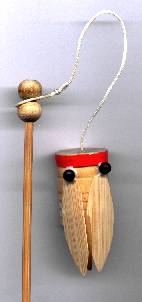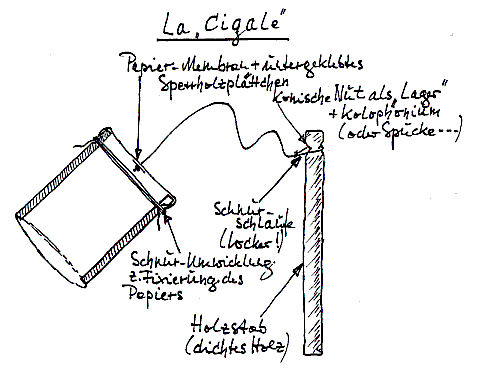 |
Hier eine indische Version der "Zikade" etwa so lang wie ein Streichholz |
Es gibt ein in Europa und Asien weit verbreitetes Kinderspielzeug, das in etwa der Lautstärke der "Ratsche" enspricht, die auf Fasnetsumzügen Süddeutschlands häufig als Radauinstrument zu hören ist. Auch wurde es früher zur Vogelabwehr in Weinbergen verwendet und ist unter dem Namen "Waldteufel" bekannt.
Das Instrumentchen dient dazu, als Kinderspielzeug einfach nur Krach zu machen bzw. in südlicheren Gefilden wie Italien oder Frankreich möglichst lautstark Zikaden oder andere Heuhüpferarten nachzuahmen.
Es besteht aus einem Stöckchen mit einer konischen Nut am einen Ende, einem starken Faden, der mit einer Schlinge in der Taille/ Nut des Stöckchens läuft und einer über einem kleinen Resonanzkasten ausgespannten Membran am anderen Ende des Fadens.
Man spuckt auf die Nut in dem Stöckchen (doch, in dem besonderen Fall
darf man das...! ) und bringt so die Schnurschlinge dazu, in der Nut etwas
fester zu haften, zu rutschen, zu haften; also Haft und Gleitreibung immer
abwechselnd, dadurch entsteht ein rauher Ton, der durch Weiterleitung im
Faden und Verstärkung in der Membran ohrenbetäubend laut
verstärkt wird.
Eine andere, etwas hygienischere Möglichkeit ist das Aufbringen von
"Geigenharz", also Kolophonium, auf/ in die
Nut in der die Fadenschlinge läuft. Auch ein kleines
Tröpfchen Tannen- oder Kiefernharz, das zu 80% aus
Kolophonium besteht (siehe ein
hübscher
französischer Artikel über die Gewinnung von Kolophonium)
funktioniert nach kurzer "Einlaufzeit" super.
Durch Herumwirbeln bringt man das Instrumentchen zum "Klingen". Der Krach, der dabei erzeugt wird, ist nicht gerade von der angenehmen Sorte. Wenn Sie empfindlich sind, kaufen Sie Ihrem Sprössling lieber eine Trompete. Ist zwar teurer, aber weit angenehmer für Ihre Ohren....
 |
Hier eine indische Version der "Zikade" etwa so lang wie ein Streichholz |
Die erzeugte Tonfrequenz ist abhängig vom Volumen des Resonanzkörpers im Verhältnis zur projezierten Fläche der Öffnung analog den im Physikteil besprochenen Helmholtz-Resonatoren. Die Klangfarbe ist unter anderem von der Membranspannung abhängig. Eine Stimmung der Instrumentchen ist also möglich.
 |
Konstruktionsprinzip der "Zikade" |
Zur Konstruktion:
Das Werkzeug:
Das Material:
Beim benötigten Material sind Sie relativ frei bei der Auswahl. Je nach
Ausführung können Sie als Resonanzkörper ein kleines Stück
Bambusrohr mit ca. 3cm Außendurchmesser oder auch eine kleine Konservendose
(Tomatenmark, Bärenmarke etc.) nehmen. Falls Sie eine Konservendose
nehmen, bitte beide Deckel mit dem Dosenöffner abschneiden und die
Kanten abstumpfen.
VORSICHT, VERLETZUNGSGEFAHR!!!
Nun sollte sich ein rauher lauter und kratziger Ton hören lassen, der je nach Umdrehungsgeschwindigkeit bzw. Resonanz-(Frequenz)-Eigenschaften des Resonators variiert und bei kleinen Resonatoren dem Geräusch von Zikaden ähnelt.
Ich wünsche Ihnen viel Spaß beim Experimentieren und nehmen Sie RÜCKSICHT auf arme Ohren...!!
Anregungen, Ideen, Kritik, Fragen ;-)) ...?
Dann Bitte Mail
an
Kite
Musical
Instruments...
...Sie geben mir damit die Möglichkeit, diese Seiten
für
Sie
weiter zu verbessern, Danke!
All Rights Reserved, Uli
Wahl
Zurück zum Seitenanfang
oder
Zurück zur Kite Musical Instruments/ Aeolian
Instruments Hauptseite
There is a children's toy widely spread in Asia and Europe, the "Cicada", which in loudness is equal to the old "Ratsche", an old German "instrument", which has been used in former times to chase away the crows hunting for grapes in the vineyards. In the meantime, more effective "automatic" scarecrows have been developed and the "Ratsche" has survived as a noise instrument on the annual carnival ("Fasnet") processions in the South of Germany.
The little children's instrument simply serves for making noise; or in the South of Europe (Italy, France, Spain) to imitate the Cicadas or other grasshoppers.
It consists of a little Stick with a conical circular groove at one end, a strong thread, which is running with a loop in the stick's groove and a little, open resonance box covered with a membrane to which is fixed the other end of the thread.
One spits onto the circular groove in the stick in order that the loop is
running a little bit "sticky" in the groove. The loop, now is running irregularly
around the stick, when the resonance box is whirled around the stick. Via
the thread, the irregularities are conducted to the membrane thus being
amplified. A "rough" tone will be developed, which is really
ear-breaking...
Another, more hygienic possibility instead of spitting would be, to use some
resin for violins (colophony), which is put into the groove with the loop
by means of a hot needle. A little drop of fir- or pine-resin is working
also, although it is more sticky than violin-resin. (See a
nice French article about
the resin production on the Oleron-Island in France.)
By twirling the resonator-box around the stick, the little instrument is emitting sound. The noise is NOT of the pleasant sort.... In case of your ears being too sensitive, better buy a trumpet for your children; will be a little bit more expensive but far better for your ears....;-)))
 |
Indian Version
of the "Cicada" as long as a match-stick |
The frequency of the generated tone depends on the volume in relation to the opening area of the resonator-box analogous to the Helmholtz-Resonators (Cubic Flutes) which are described in the "Physics-Part" of that site. So a tuning of the little instruments is possible.
.
 |
Construction of the "Cicada" |
The Construction:
Tools required:
Das Material:
You are free in teh choice of the material. Depending mainly on the size,
you can choose a piece of bamboo-tube or a tin as a resonance body.
(Tomato-puree, coffee-milk tin etc.). In case of choosing a tin, cut off
both lids with the can opener and make dull the sharp
metal!!
Caution, DANGER of INJURY!!!
Now a hoarse sound should be emitted, which varies according to the revolution speed and resonance properties of the resonance box. The sounds resembles the voice of cicadas or seagulls.
I wish you having much fun while experimenting and TAKE CARE on spectators ... and innocent listeners...!!
New ideas, criticism or questions ;-)) ...?
Please Mail
it to
Kite
Musical
Instruments...
...and give me the possibility to improve these pages for YOU. Thank
you!
All Rights Reserved, Uli
Wahl
Back to the top of the page
or
Back to the Mainpage Kite Musical Instruments/ Aeolian
Instruments